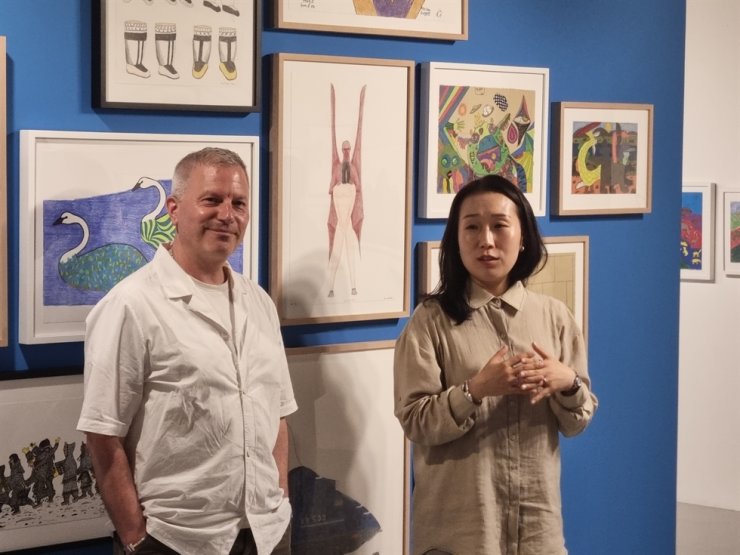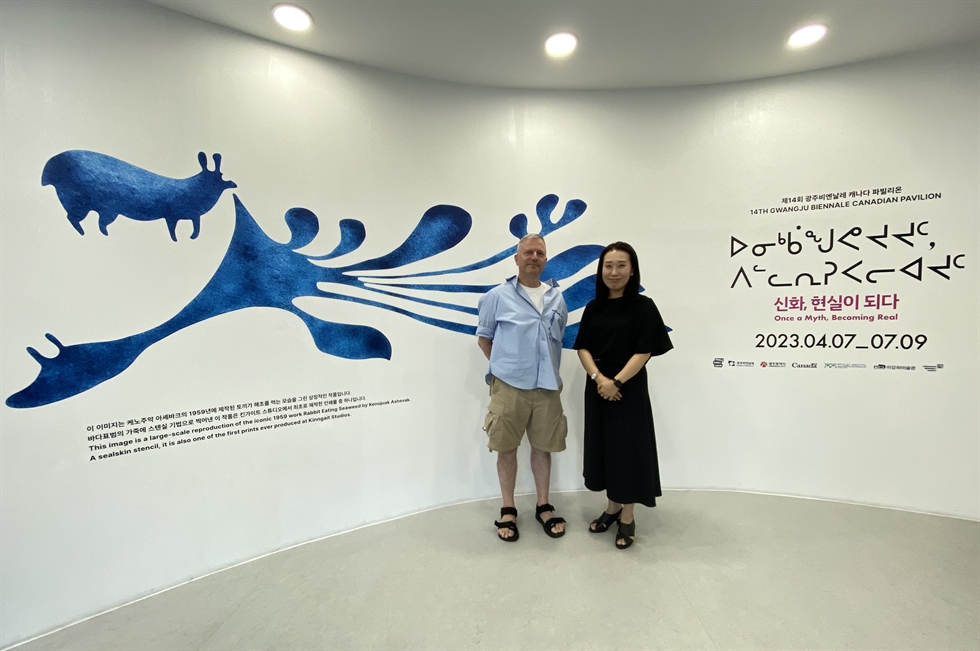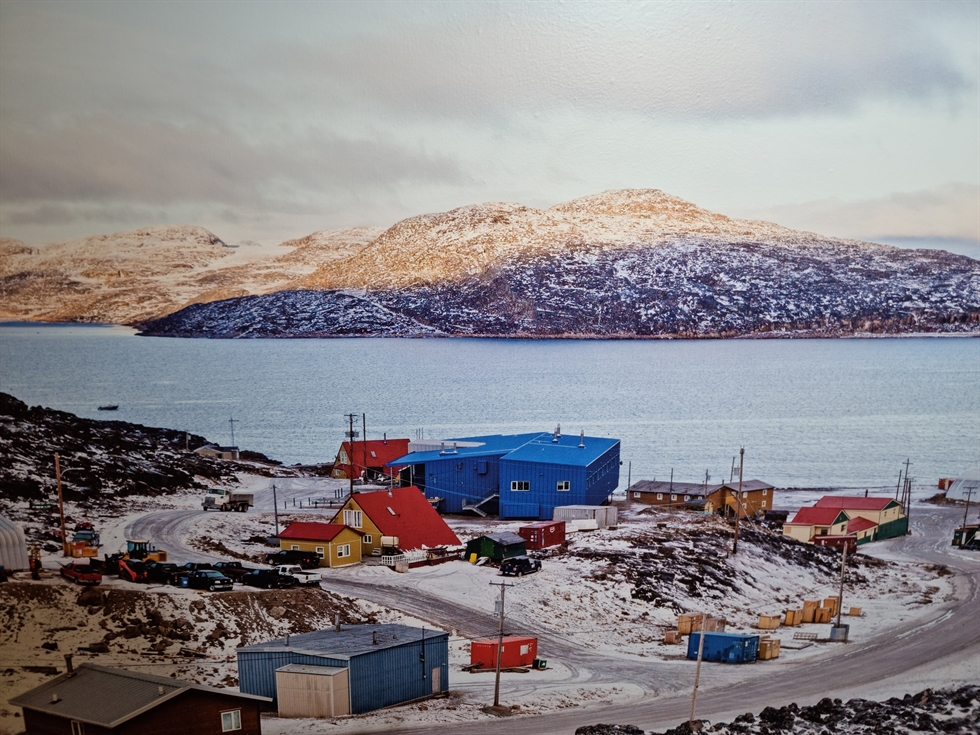[The Korea Times]

West Baffin Art Collective marketing manager William Huffman and Lee Sun, co-curators of the "Once a Myth, Becoming Real" exhibition on Inuit artwork, pose together at the exhibition in the Canada Pavilion of the Gwangju Biennale at the Lee Kang Ha Art Museum in Gwangju. Courtesy of Arlo Matisz
광주 이강하미술관에서 광주비엔날레 캐나다 파빌리온 전시에서 함께 포즈를 취한 이누이트 전시 "신화, 현실이 되다" 공동기획자 웨스트바핀 협동조합 마케팅 매니저 윌리엄 허프만과 이선, 알로 마티즈 제공.
By Arlo Matisz
Art from around the world was displayed at the 14th Gwangju Biennale, which ended its 94-day run earlier this month. Of the nine national pavilions, the Canada Pavilion was a little different. It displayed 90 artworks from 32 Inuit artists, products of the West Baffin Art Collective in Kinngait (Cape Dorset) in Canada's northern territory of Nunavut.
"What are the commonalities between Gwangju's history and people, and the people and history in Kinngait? This is all about cultural resilience and the values of democracy and freedom, the idea of thinking in a way that doesn't need to be confined," said William Huffman, the marketing manager of the West Baffin Art Collective who co-curated the exhibition with Lee Sun. "This is also about looking at language as one of the things that unifies people. Every invader from East Asia has been here trying to do something to Korea, ripping down buildings, forcing them to speak another language, and that's exactly the history of the arctic."
"Especially in Gwangju, where the May 18 pro-democracy movement took place, I think the exhibition, which introduces the life, culture and modern art of the Inuit people, a minority in Canada, is very meaningful in terms of timing," Lee said. "I think that respect and understanding for minorities and some love and solidarity of the Inuit community have been artistically embodied in the exhibition."
But how did this work come to Korea in the first place? Huffman happily shares how he was the last to learn that he would be curating the exhibition.
It started when Qavavau Manumie, an Inuit artist from Nunavut, was showing in Sydney, and the artistic director of the Busan Biennale saw his work there.
"We got a phone call saying they'd love to show some of this work in Busan. I talked to my board about it, because they'd been interested in Asia, as we had no presence there," Huffman said. "There is a lot of cultural currency to Seoul, a lot of attention paid to the museums here. So, I came to Busan to see what's going on, and people were going bananas about Qavavau's work! There were crowds. I was taking photos and texting back to Kinngait and saying 'Can you believe this?' I shouldn't say that I'm surprised, but I have to step back and be modest, and be like, 'OK, it's happening again.' This is crazy but I have to understand that there something about this work that's resonant here."
During that visit last September, the Canadian Embassy asked Huffman to go to Gwangju to meet with the Gwangju Biennale organizers. "So, for two days in Gwangju, they are taking me around to these great venues, and the second day they keep talking to be about this Canadian Pavilion," he said. "I said 'Who's doing this Canadian pavilion?' I was assuming it's the National Gallery of Canada or the Vancouver Art Gallery. And they looked at me and said '…You're doing it. Why do you think you're here?' Talk about lost in translation! I was the last one to know I was doing the Canadian Pavilion. I want to underscore this. We went from the September invitation, to December selection of work, to shipping by February, framing in March, to installation and opening in April. That's impossible. How did we get involved? We just don't say no to an opportunity."
The Inuit art exhibition, titled "Once a Myth, Becoming Real," was held at the Lee Kang Ha Art Museum, named after curator Lee's father.
When entering the exhibition in Gwangju, visitors could see an enlarged print of "Rabbit Eating Seaweed," a work by Kenojuak Ashevak, arguably the grand dame of Inuit Art and one of the original creators at Kinngait Studios.
The title of the show is displayed in Inuktitut in large text, above smaller Korean letters and then English at the bottom.
"This is a gesture to the language of the Inuit people, the fact that it appears here, probably for the first time in the country, on a wall in the museum," Huffman said.

A large-scale reproduction of Kenojuak Ashevak's 1959 work "Rabbit Eating Seaweed" is on display, left, at the entrance to the Canadian Pavilion. To the right is the exhibition's title in Inuktitut letters on top, then Korean and then English. Courtesy of Ju Sae-woong
케노주악 아세바크의 1959년 작품 "해초 먹는 토끼"의 대규모 복제품이 캐나다관 입구 왼쪽에 전시되어 잉따. 오른쪽은 위에서부터 이누이트어, 한글, 영어 순으로 전시명이 적혀있다. 주세웅 제공.
"Rabbit Eating Seaweed" is also the name of the upcoming exhibition of Canadian Inuit Art in Seoul's Jamsil branch of Lotte Department Store.
"It's super exciting to be working with Lotte," said Huffman, who is also curating the Seoul exhibition which starts Wednesday and runs until Oct. 3. "I think that the audience in Seoul is going to be amazed at what they see."
More amazing than how this art came to be invited to Korea is the history of how it was made. Asked to explain the "blue box," which is how he refers to the Cape Dorset Cultural Centre and Print Shop, Huffman spoke with passion and admiration.
"It was five years of my life. We generated $13 million to build that blue box. People ask 'Why is this work so extraordinary?' Because of where it comes from and the circumstances it was created in."
He paused and then began a brief history lesson on the West Baffin Eskimo Cooperative.

Cape Dorset Cultural Centre and Print Shop, the blue building, can be seen in Kinngait (Cape Dorset) in Canada's northern territory of Nunavut. Courtesy of Cape Dorset Cultural Centre and Print Shop
파란색 건물인 케이프 도세트 문화 센터 및 인쇄소는 캐나다 북부 영토인 누나바트의 킨가이트(케이프 도세트)에서 볼 수 있다. 케이프 도세트 문화센터 및 인쇄소 제공
"In 1959, and the shack still exists, there were 10 founding members of the West Baffin Cooperative. They started to draw, and their drawings were meant to be prints. James Houston (the celebrated Canadian artist who introduced printmaking to the Inuit) convinced the federal government that they should build an art studio. I still think this is the most absurd prospect, and I'm someone from the art world, and I work for the organization!" William said. "Sixty-three years later, we're one of the most successful fine art studios in Canada. That blue box is the latest iteration. That studio is one of the most sophisticated studios on the planet. We bring people from all over the world, all the time. The Canadian government got convinced by someone that they should create an art studio in the Artic and make this the economic engine that's going to sustain a community. The next thing is the community takes ownership over it, and it gets moving, and there's art being produced, and it's being distributed internationally."
He continued, "The thing that nobody seems to understand is that this is the first social enterprise on the planet. This was owned by the community, for the community, and was about arts and culture that sustains the community. It's also one of the oldest and most successful Indigenous-owned organizations on the planet. It continues to be owned by the community; the board of directors is 100 percent Inuit. Board meetings are conducted in Inuktitut. People seem to understand the beginnings, which is government intervention, to right the wrong made by relocating people. But people are not understanding that this is not colonialism. This is a success story. And it is incumbent on our organization to look at how we can provide a roadmap, a toolkit, how we can share success stories."
Linda Bradley, an art teacher from the Kawartha Pine Ridge District School Board in Peterborough, Ontario, was visiting Korea for the first time on invitation from Huffman.
She described a virtual tour that her grade 6 students took simultaneously with Kinngait students on an onsite tour of the blue box. "It was an amazing opportunity to connect Indigenous students in the two areas. The kids could talk to their peers and make connections. It was a number of different curriculum values. It was geography, science, obviously art and history. Once we had done the tour, we met the artists who were there, the students got to see some artists at work, and see the gallery and meet some artist that were there, and this was all with the other students in Kinngait."
Huffman stressed the importance of this particular geographical connection. "The school board has a mandate for Indigenous engagement, but I imagine this was the first time it had any engagement with the Inuit community in the country," he said. "I find that gap remarkable because I spend so much time bridging it."
As the possibility of a career in the fine arts seems slim for most, it requires explanation of how this community is able to see such opportunity in the creation of art. Parents send their kids to the Cape Dorset Cultural Centre and Print Shop with encouragement to become artists. William detailed why art was an 'out' in this community.
"The idea is that you can make money making art, and of course this is unusual unless you're an elite in the art world," he said. "You can make money off of this art because there is a whole infrastructure, where you have a dedicated representative. That's what the blue box is. We provide you with the tools, the media, the encouragement, the professional development. We provide you with the exhibitions. As an agent, we actually do more than most commercial galleries. The idea that we will give you advances for your drawings, sculptures and prints. People ask all the time 'Why is it you buy everything as opposed to waiting for it to sell and giving the artists a percentage of the sale?' The artists in this community can't wait. They need to buy diapers and food, and fix their sewing machine. The other part that makes it a good 'out' is the depth of pride that the community has in art making. I've had artists say to me, 'If I didn't have my art practice, I'd be dead.' That's not figurative."
He said the blue box gives people a place to go, and a community to connect with.
"It gives people the encouragement they wouldn't normally have if they're isolated or if they don't have family," he continued. "In the studio is a hive of activity. You have people interacting with each other, in a way that is not only 'Let me help you solve problems with your artwork,' it's like 'Oh you're feeling a little depressed today, let's talk, let's have a coffee.' I go up there and I know people have waited for me to come to talk about their careers or what they find challenging. That's unusual. Artists function almost entirely independently, unless they have the ability to access a studio. You're making work on your own. So, the idea is that we have a studio there that will allow people to have those moments of thinking differently about what's around you. It's a distraction from the reality of your circumstances. It's being able to know that there's something else beyond what it is to live in the Arctic and be isolated. That experience is more sophisticated than people imagine, more than I imagine. The money thing is important. People need money. But you can go there, and you're totally protected and feel safe, and you can say and do things that you couldn't do anywhere else. You can say to me 'I have a crazy idea, what do you think?' and 'What do I do?' 'Yes of course, amazing. Let's do a project in Gwangju!' The 'out' is practical and is extremely conceptual in that this fosters creative thinking and the ability for people to manifest things they wouldn't normally in an Artic environment, in that isolated lifestyle."
"They wouldn't imagine their stuff being here in Korea?" he's asked.
"Well now, the more that we do it, the more they ask, 'Where's my stuff going to be next?'
Arlo Matisz is an economics professor at Chosun University and the host of GFN's talk show "This Morning Gwangju," which broadcasts from 8 a.m. to 9 a.m. Monday through Friday.
/ 기자 : Arlo Matisz 알로 마티즈